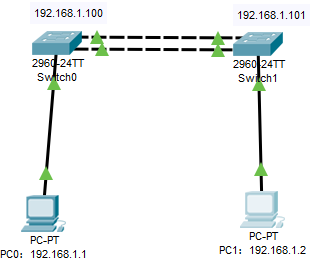First, the topology of FIG.

Second, the experimental procedures
Further a switch with the same switch configuration, but when the link member and the polymerization number of different polymeric composition mode of the port member port belongs. (Read below)
Switch(config-if-range)#channel-group 2 mode passive
1, set to host IP
In the switcher experiment, IP switches and a host of needs in the same network segment, and can not conflict with.
2, is provided to the switch IP
Switch>enable Switch#config Configuring from terminal, memory, or network [terminal]? Enter configuration commands, one per line. End with CNTL/Z. Switch(config)#interface vlan 1 Switch(config-if)#ip address 192.168.1.100 255.255.255.0 Switch(config-if)#no shutdown Switch(config-if)#exit
3, is provided Link Aggregation
Switch(config)#interface range fastEthernet 0/1-2 Switch(config-if-range)#switchport mode trunk Switch(config-if-range)#channel-protocol ? lacp Prepare interface for LACP protocol pagp Prepare interface for PAgP protocol Switch(config-if-range)#channel-protocol lacp
Switch(config-if-range)#channel-group 1 mode ? active Enable LACP unconditionally auto Enable PAgP only if a PAgP device is detected desirable Enable PAgP unconditionally on Enable Etherchannel only passive Enable LACP only if a LACP device is detected
Switch(config-if-range)#channel-group 1 mode active
FastEthernet above the 0 / 1-2 1-2 is an interface connected to two switches.
4, do load balancing
Switch(config-if)#exit Switch(config)#port-channel load-balance src-ip
supplement:
Cisco switch link aggregation according to the protocol used can be divided into three operating modes LACP mode, PAgP mode and On mode.
There are five different specific port mode under three operating modes active, passive, auto, desirable, on.
Wherein the active and passive use LACP protocol work, and desirable using Auto PAgP protocol work, it is forced ON enable link aggregation, corresponding to three Chinese manual aggregation mode.